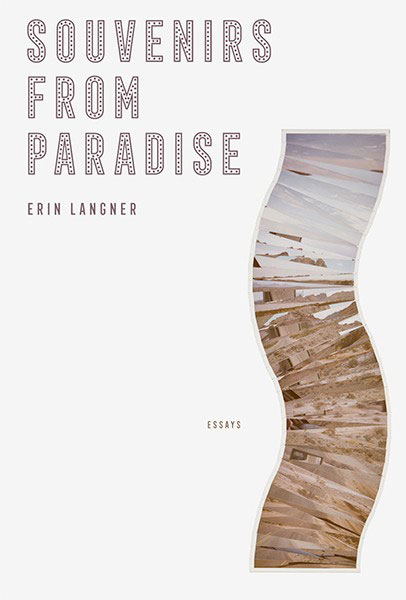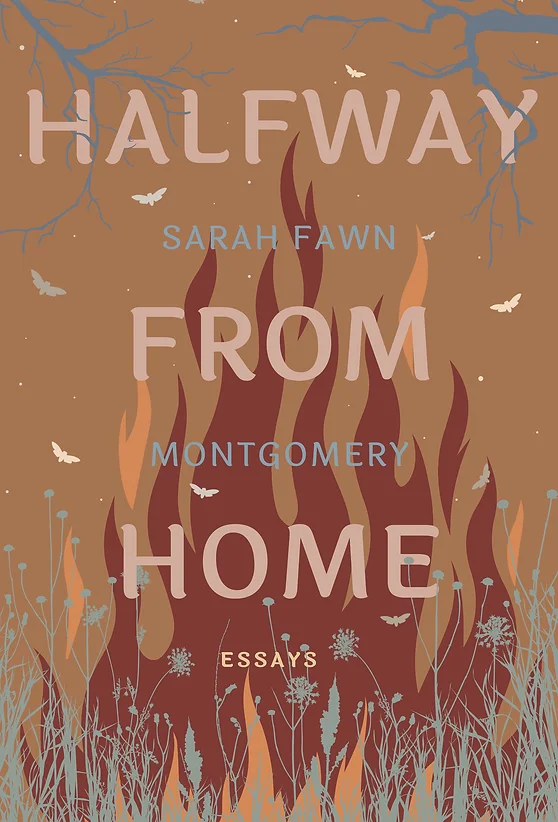TETHER AND FLOAT: THOUGHTS ON TWO NEW ESSAY COLLECTIONS
by Beth Kephart
SOUVENIRS FROM PARADISE
Erin Langner
Zone 3 Press
HALFWAY FROM HOME
Sarah Fawn Montgomery
Split/Lip Press

What would happen if, when we thought about essays (the power they might wield, the indignities they suffer), we thought about tether and float? The ways in which the essay knits itself into its own grounding facts, on the one hand. The ways in which it transcends them, on the other.
Essays erupt from the lives that we live. Our hopes, which surge and thin. Our grief, which stills and screams. Our joy, which can’t be fixed. Our desire, which we understand until it makes no sense to us, until we don’t make sense to us, until we write the essay to find out, or read the essay hoping to find both the shimmer of the world and the maybe of ourselves.
The math of an essay is not plot times words, not questions equals answers, not A plus B sums out at C. The math of an essay is disclosure and search, supposition and erasure, reassertion and pause. What happened is the essay’s tether. Why it mattered, or what it means, or the poetry it incites—all of that (and the magic of more) is the float.
This past week, I read two essay collections by two gloriously talented writers who have mastered the tether and the float. The first, Souvenirs from Paradise, is the work of Erin Langner, whose obsession with Las Vegas binds her twelve pieces with situational clarity. The second, Halfway from Home, is Sarah Fawn Montgomery’s seventeen-part exploration of the places she has left and made, the haunts she carries forward, the dust on her feet, the groundhog in her yard, and the counterweights of urgency and impermanence.
Langner’s writing about Las Vegas is also (often) Langner’s writing about the mother who died suddenly when she was nine and the incalculable life that ensued. Montgomery’s writing about her halfway places operates, equally, as a meditation on the family she left (but she never fully leaves) behind—a father who built fences, a crowd of foster siblings carrying the eruptive seeds of violence, and a mother depleted by the magnitude of so much need and strife.
In both cases, these writers might have simply written plot. This is what happened to me. Instead, they built accordion-fold worlds. Langner, for her part, binds the art of James Turrell, the architecture of the strip, the ambitions of Steve Wynn, and the tragedy of Brittney Spears, among much else, into the slippery memories she has of her mother. Returning again and again to Vegas, moving in and out of hotels, pushing against the crowds, Langner comes to understand that her Vegas obsession is not just a distraction. It is her way back to her self. From “The Art Experience”:
Maybe, at their best, our obsessions keep us honest. They convince us we have found a distraction. An escape. A window to the clouds, a sculpture against the breaking waves, a wall of light that gives us something to chase in the absence of knowing the “real thing” we are after. But instead, they suspend us, willingly, yet indefinitely, in the difficult thing we were avoiding all along. They force us to finally look.

Montgomery, for her part, counterbalances the mysterious undercurrents of her personal world—a claustrophobic childhood home continually divided to make room for more and more siblings, an adult home mercifully sheltered by surrounding conservation land but also terrifyingly pierced by the sounds of legal hunters, a stint in between in Nebraska—with the fluid particulars of cartography, timekeeping, tree communication, mining, wasp nests, and fire. Her history is a form of poetics. Her storytelling is a geometry Her exquisite first and final essays bracket her unquantifiable love for the father who taught her to dig. From “Excavation”:
He moves down the line, leaving precise holes behind. Later he fills each hole with cement, a fence post planted as if a flag. At first the flags are of discovery, of ownership, but when he builds the fence, the flags become boundaries and borders, keeping things in and out, determining where one thing ends and another begins.
Using his tools to excavate and alter the earth makes my father mapmaker, enforcer, creator. Because he shapes the soil, he shapes the world.
Shaping the soil, he shapes the world. Shaping their essays—braiding, collaging, reversing, reassessing—Langner and Montgomery shape our ideas of what it is to be tremulous and uncertain, questing and not quenched. They are writers to be reckoned with, writers to be read and taught.
 Beth Kephart is the award-winning author of three-dozen books in multiple genres, an award-winning teacher, co-founder of Juncture Workshops (now running the Story of You lecture series), and a book artist. Her new books are Wife | Daughter | Self: A Memoir in Essays and We Are the Words: The Master Memoir Class. More at bethkephartbooks.com and etsy.com/shop/BINDbyBIND.
Beth Kephart is the award-winning author of three-dozen books in multiple genres, an award-winning teacher, co-founder of Juncture Workshops (now running the Story of You lecture series), and a book artist. Her new books are Wife | Daughter | Self: A Memoir in Essays and We Are the Words: The Master Memoir Class. More at bethkephartbooks.com and etsy.com/shop/BINDbyBIND.
Read more from Cleaver Magazine’s Book Reviews.



